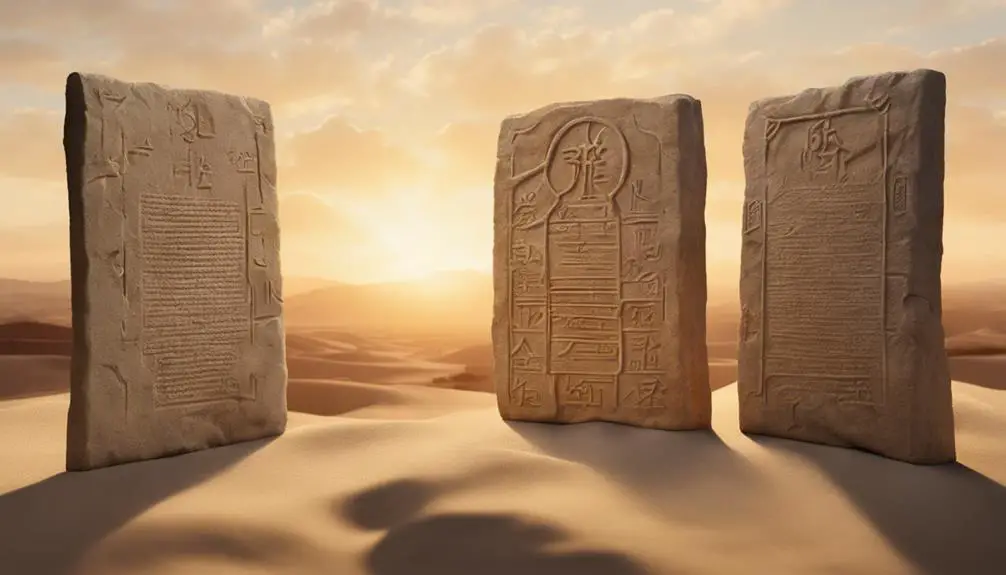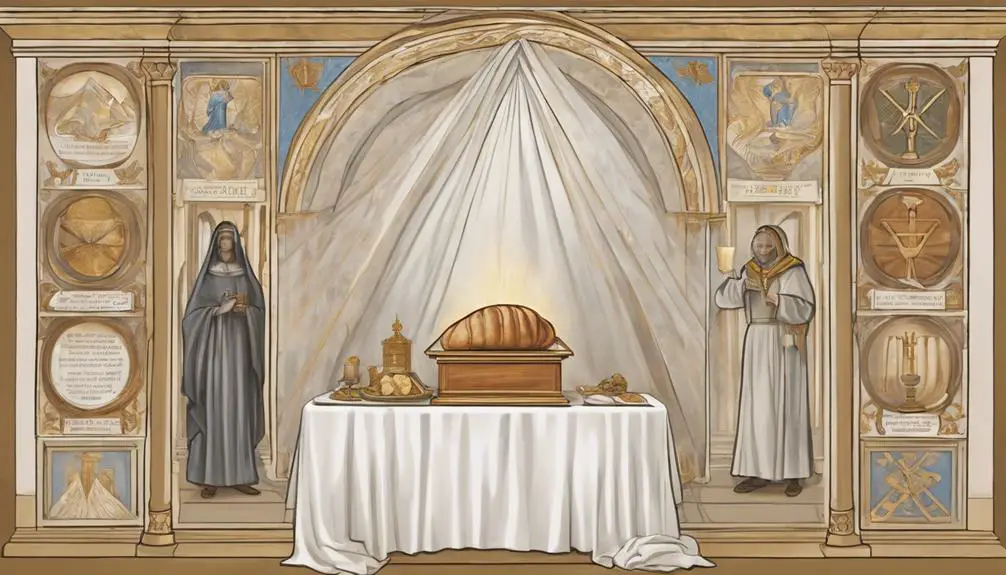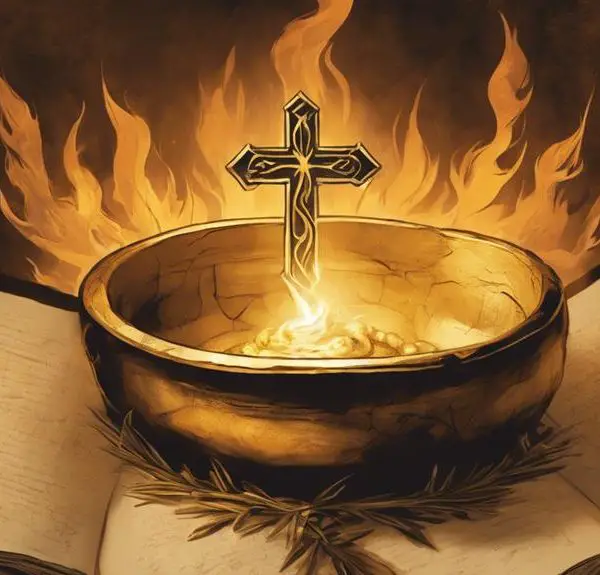Uncover the profound symbolism of the number five in the Bible, from divine grace to human struggle, and its mysterious role in faith's narrative.

What Does the Number Five Mean in the Bible
Imagine walking through a vast desert, feeling the weight of your journey, and then stumbling upon five oases, each offering a different form of sustenance.
In the Bible, the number five serves as a symbol with rich layers of meaning, from the Pentateuch, the foundation of faith, to the five loaves that fed thousands. It's woven into narratives of provision, atonement, and even victory over seemingly insurmountable challenges.
As you explore these instances, you'll uncover how this number might offer insights into the deeper workings of faith and grace. Let's embark on this journey together, and you might just find what you're seeking in the most unexpected of places.
Key Takeaways
- The number five symbolizes divine grace, seen in the Pentateuch and the Tabernacle's design.
- It represents God's miraculous provision, as illustrated by the five loaves and five offerings.
- Five signifies victory over challenges, echoed in David's selection of five stones against Goliath.
- It underscores the importance of faith and courage in spiritual warfare, teaching resilience and reliance on divine assistance.
The Pentateuch: Foundation of Faith

What foundational role does the Pentateuch, the first five books of the Bible, play in establishing the core tenets of faith for countless believers? At the heart of this question lies the profound significance of Mosaic authorship and the covenant's importance, which are pivotal in understanding the Pentateuch's essence. Traditionally attributed to Moses, these texts serve not only as a historical account but also as a divine revelation, offering a unique blend of law, narrative, and theology that lays the groundwork for the entire biblical message.
The covenant significance, especially, is central to grasping the Pentateuch's role in shaping faith. This concept introduces you to a God who initiates a relationship with His people, setting conditions that guide moral and social behavior. It's through these covenants that you see a God who's both transcendent and imminently involved in the affairs of humanity. The progression from the Abrahamic Covenant to the Mosaic Covenant illustrates a developing understanding of divine expectation and human responsibility, underpinning the moral and ethical codes that still resonate with believers today.
Moreover, Mosaic authorship lends authority and authenticity to these writings, reinforcing their status as foundational texts. You're encouraged to see these books as more than historical documents; they are, in essence, a divine instruction manual for life, worship, and community. In analyzing the Pentateuch through the lenses of Mosaic authorship and covenant significance, you uncover the roots of many core tenets of faith that continue to guide and inspire believers across generations.
Five Loaves: Miraculous Provision

In the narrative of the five loaves and two fish, you're presented with a profound demonstration of Jesus' power to provide miraculously, embodying a pivotal moment that transcends mere physical sustenance. This episode, steeped in divine symbolism, showcases the 'Feeding multitudes' through an act of 'Divine multiplication,' pointing beyond the physical realm towards spiritual truths. It's a testament to the boundless compassion and providence of the divine, encapsulated in a moment that has been meticulously analyzed and revered across generations.
To paint a vivid picture of this miraculous provision, consider the following:
- The Initial Offering: A small boy's humble contribution of five loaves and two fish, seemingly insufficient for the vast crowd, becomes the foundation for a miracle. This act underscores the principle that in divine economics, what's offered in faith, regardless of size, holds infinite potential.
- The Act of Multiplication: Jesus' blessing and breaking of the loaves, followed by the distribution, serves as a visual and tangible manifestation of divine abundance. It's a powerful illustration of how divine provision transcends human limitations and logic.
- The Leftovers: The collection of twelve baskets full of leftovers, after feeding thousands, emphasizes not just the sufficiency but the superabundance of God's provision. It's a stark reminder that divine generosity knows no bounds.
This narrative serves as a profound reminder of the limitless capacity of divine provision and the principle of faith's exponential impact when placed in the hands of the divine. It's an enduring testament to the power of 'Divine multiplication,' illustrating that with faith, what seems insignificant can lead to overwhelming abundance.
The Tabernacle's Symbolism

Turning our attention to the Tabernacle, its intricate design and furnishings carry deep symbolic significance, mirroring the principles of divine presence and covenant in the biblical narrative. The Tabernacle, as outlined in the Scriptures, wasn't just a physical structure but a theological statement, embodying the relationship between God and His people. Its sacred dimensions and the specific materials chosen for its construction were imbued with meaning, pointing to aspects of God's character and His intentions for humanity.
The sacred dimensions of the Tabernacle, meticulously described in the book of Exodus, reflect a divine order and perfection. The use of the number five in the construction of the Tabernacle—such as the five pillars at the entrance—symbolizes grace, reinforcing the idea that God's dwelling among His people is a gracious act, underscoring His mercy and benevolence. This numerical symbolism extends to the priestly garments as well, which were designed not only for functionality but as a representation of holiness and separation unto God. The ephod, breastplate, and other elements of the High Priest's attire were detailed with precision, signifying the mediator's role between God and man, and highlighting the necessity of purity and divine selection in those who serve before the Lord.
Analyzing the Tabernacle and its components, including the priestly garments, reveals a profound theological depth. These elements underscore the themes of covenant, redemption, and divine fellowship, offering a rich tapestry of symbolism that speaks to the heart of the biblical message. Through these sacred dimensions and vestments, the Tabernacle serves as a tangible representation of an intangible truth: God's persistent desire to dwell among His people and guide them according to His will.
Five Offerings: Atonement and Grace

Delving deeper into the thematic significance of the number five in biblical texts, we encounter the five offerings described in Leviticus, each symbolizing facets of atonement and grace that are foundational to understanding divine forgiveness and human sanctity. These sacrificial rituals embody the profound nature of divine mercy, illustrating a pathway for believers to reconcile with God through acts of devotion and contrition.
The offerings, meticulously detailed in Leviticus, include:
- The Burnt Offering: Symbolizing total surrender to God's will, this offering underscores the believer's devotion and desire for atonement.
- The Grain Offering: Representing acknowledgment of God's provision and blessings, it's an offering of thanksgiving, minus the shedding of blood, highlighting sustenance derived from divine mercy.
- The Peace Offering: A celebration of reconciliation and communion with God, it emphasizes the restoration of relationships through divine grace.
These rituals, beyond their literal sacrificial context, point to deeper spiritual truths. They prefigure the ultimate sacrifice of Jesus Christ, whose atonement encompasses and transcends these offerings, providing a perfect, once-for-all pathway to reconciliation with God. Through these offerings, the Bible articulates a theology of grace, where divine mercy meets human frailty. They serve as a vivid reminder of the cost of sin and the infinite value of grace bestowed upon humanity. Understanding these sacrificial rituals deepens one's appreciation for the profound depth of divine mercy, emphasizing that atonement isn't merely an ancient ritual but a timeless gift of grace.
David's Stones: Overcoming Giants

Reflecting on the profound depth of divine mercy and atonement through sacrificial rituals, we now explore the symbolic significance of the five stones chosen by David to confront Goliath, illustrating the power of faith and divine assistance in overcoming life's giants. David's choice wasn't arbitrary; each stone he selected against Goliath's defiance symbolizes a layer of spiritual warfare and the victory of faith over fear.
David's faith, deeply engrained in the heart of his strategy, wasn't just about physical prowess but a profound trust in God's power to deliver. He understood that the battle was the Lord's, an insight that empowered him to face a giant who defied not only Israel but its God.
Here's a breakdown of the symbolism behind each stone:
Stone |
Symbolism |
|---|---|
First |
God's sovereignty and the acknowledgment that He alone would guide the stone's path. |
Second |
The strength and courage granted to those who believe, enabling them to face their giants. |
Third |
The power of God's word, sharper than any two-edged sword, cutting through fear and doubt. |
Fourth |
The unity of God's people, standing together in faith against common threats. |
Fifth |
Redemption and victory, a reminder of God's faithfulness to deliver His people. |
These stones, more than mere weapons, were manifestations of David's faith, serving as a testament to the power of divine assistance when faced with Goliath's defiance. They remind you that with faith, no giant is too formidable, no challenge insurmountable.
Frequently Asked Questions
How Does the Number Five Relate to Divine Grace Outside the Context of the Five Offerings?
You're exploring how five symbolizes divine grace beyond the five offerings. In biblical numerology, five often intersects with Graceful Numbers and the Five Elements, embodying completeness and God's grace.
This concept, while rooted in scripture, extends to a broader interpretation where five represents God's kindness and favor in the natural and spiritual realms. Analyzing this, you'll find that five's significance is deeply embedded in a scriptural and scholarly understanding of divine grace.
Are There Any Prophetic Implications of the Number Five in the Book of Revelation?
In the Book of Revelation, the number five carries prophetic significance, especially seen through the Five Seals and the role of angelic presence. This numerical pattern isn't just arbitrary; it's deeply woven into the narrative's fabric.
Analyzing these instances, you'll uncover layers of meaning, highlighting divine intervention and judgment. Scripture scholars argue these elements underscore a complex, symbolic landscape, demonstrating how numbers can frame eschatological events and divine messages.
How Is the Number Five Represented in the Lives of Biblical Characters Other Than David?
In exploring biblical narratives, you'll find that the number five prominently appears beyond David's story. Consider the account of Zelophehad's five daughters, who challenged inheritance laws, leading to groundbreaking legal reforms. This story illustrates the transformative power of faith and courage.
Additionally, the symbolism of five stones, chosen by David to defeat Goliath, recurs, signifying divine strength and provision. These instances underscore a thematic resonance of redemption and divine intervention in biblical texts.
In What Way Does the Number Five Influence the Structure or Organization of Psalms or Proverbs?
In exploring how the number five influences biblical structures, you'll find Psalms divided into five sections, mirroring the Pentateuch's organization. This division underlines thematic and theological motifs, enhancing your understanding of its spiritual depth.
Similarly, Proverbs' wisdom is segmented, embodying practical life principles. This structuring isn't coincidental; it's a deliberate design to guide your interpretation and application of these scriptures, showcasing a complex, layered approach to conveying divine wisdom and instruction.
Can the Significance of the Number Five Be Linked to New Testament Teachings Outside the Context of the Five Loaves?
You're diving deeper, beyond the five loaves, into the New Testament's teachings.
The significance of five subtly threads through, notably at Pentecost. Here, the Holy Spirit's descent, 50 days post-Resurrection, mirrors the number's essence in fresh beginnings.
Moreover, the Apostolic symbols, linked to the church's foundations, echo this theme.
Analyzing these instances, you uncover a scriptural pattern where five's symbolism extends, enriching your understanding of biblical numerology.
Conclusion
In your journey through the sacred texts, you've seen how the quintet echoes divine grace and provision. The Pentateuch lays your foundation, while the five loaves nourish your faith.
The Tabernacle's design whispers of redemption, and the quintuple offerings illuminate the path to atonement. Even in the face of life's Goliaths, remember David's stones, symbols of overcoming the seemingly insurmountable.
Thus, in life's tapestry, the number five is woven as a thread of divine intricacy, guiding you towards understanding and enlightenment.



Sign up